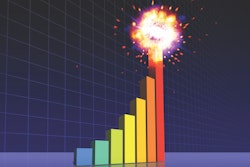According to the CBA report “The CPG Post-Pandemic Outlook,” COVID-19 has, in ways, permanently changed consumer behavior, and consequently the CPG industry.
Trend 1: Consumer Product Demand Will Remain Elevated
CPG sales soared 21% YOY in second quarter 2020, and Consumer Brands estimates that economic activity will not return to pre-pandemic levels until late 2021 - employment levels will not recover until well into 2022 or even 2023.
“Despite the vaccine, Americans will still consume more at home, keeping sales of CPG products elevated for much of 2021 — if not beyond. Consumer Brands expects 2021 CPG purchases to decelerate between 1% and 2% from 2020,” said the report. Even with this settling, the annual rate of purchases is estimated to be 7% or 8% above those of 2019.
One of the biggest influences on this trend is the ‘new normal’ of the remote worker. More than 82% of employees who have worked remotely during the pandemic want to continue to do so, at least some of the time, with resulting at-home consumption of more products for these workers.
Trend 2: Changes to CPG Supply Chains
Because of the rapid growth of e-commerce shopping during the pandemic, CPG supply chains had to pivot to higher inventory levels and more innovation.
According to the report, almost half (47%) of consumers said they used online ordering for delivery or click-and-collect services during COVID-19. Of those, 77% plan to continue using them after the pandemic. They also reported plans to stock up on products that were most in demand during the pandemic, and to make more infrequent trips to the grocery store with larger purchases per trip.
Tom Madrecki, Consumer Brands’ Vice President of Supply Chain and Logistics said, “The explosion of e-commerce will force an evolution for CPG and retailer collaboration and bring with it a host of questions around everything from the number of SKUs to consumer data. If there were ever a time to overhaul processes, transform operations and pivot for the future, it’s now.”
Madrecki’s forecast cites investments in technology that drive efficiency; discussion on how to improve efficiency and resiliency; and how to meet new retailer requirements. Companies will shift from the linear supply chain toward a supply network, leveraging real-time and consumer-specific data, and e-commerce will reshape the shopping landscape, with success hinging on key issues like addressing last-mile costs.
Trend 3: Consumer Expectation will Force Improved Recycling Systems
While consumers are demanding sustainable corporate action – particularly over plastic waste – consumer behavior is also key to successful recycling programs.
Consumer Brands Vice President of Packaging and Sustainability Meghan Stasz said, “…there is no perfect packaging material. There are pros and cons to the environmental footprint of every material and CPG companies are increasingly making packaging decisions based on what minimizes that footprint.”
However, America’s recycling infrastructure has long had issues, and when China’s National Sword policy eliminated acceptance of U.S. recyclables, our “patchwork” of 10,000 separate recycling systems was left to try to deal with the remaining waste – “all operating under different rules and municipal budget constraints, with no requirements to report metrics and no plan for a federal government solution in sight. It also exposed the waste management and recycling processors that failed to update their infrastructure.”
Said Stasz, “For far too long, innovation has been siloed, but what good does it do if a CPG company invests in research to find a way to make flexible plastics that are easily recycled if there isn’t a system capable — or willing — to take them?”
And ultimately, consumer participation is a key element to a successful recycling cycle. “Individual consumers may not feel they have the influence to make an impact on the environment, but they are one of the critical players in advancing a world without waste,” said Stasz.
Trend 4: Consumers Demand Product Transparency
81% of Americans were estimated to have smartphones in 2019, and the pandemic forced even more widespread adoption of touchless and digital solutions. Optimizing the space on a product label has long been an issue, and digital labels not only provide unlimited space for product information, but also provide opportunity for immediate updates.
Betsy Booren, Senior Vice President of Regulatory and Technical Affairs at Consumer Brands, envisions a digital product shelf that will feature a system that signals to the consumer verified product information, similar to Twitter’s blue checkmark, to dispel incorrect third-party claims. She said, “Online information provided by the manufacturer gives consumers a trusted place to go and counters the multitude of bad information that they could find across the internet.”
Trend 5: Consumers will Expect CPGs to Drive Societal Change
Consumer buying trends include company perception – both the values and practices such as how employees are treated, and social justice issues. Social media feeds these company perceptions, and consumers want to see companies they support doing good.
And according to the report, CPG companies have changed where and how they are investing as a result of COVID-19, including essential employee incentive pay, and enhancing workplace safety and hygiene features.
Also, 42% of Americans surveyed said that buying from companies that have strong diversity and inclusion practices was important to their purchasing decisions.
CPGs are making these changes to both internal operations, and to supplier and vendor contracts to ensure that practices are consistent with their own company values. One example is Target, who has programs to incentivize first-tier suppliers to buy from second-tier suppliers that are minority owned.




























